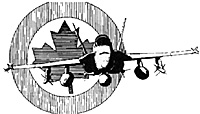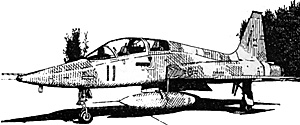 At the end of World War II, Canada possessed the fourth largest
Air Force in the world. The RCAF was a vital contributor to victory
in Europe and the Pacific. After the war came demobilization, only
five squadrons of aircraft were retained from the original seventy-
eight. Canada's first jet aircraft was a Gloster Meteor, on loan from
the British for test and evaluation. The smaller Vampire F.3 was
actually selected for initial squadron use. It's service life was from
1948-56, and eight squadrons were to use the type.
At the end of World War II, Canada possessed the fourth largest
Air Force in the world. The RCAF was a vital contributor to victory
in Europe and the Pacific. After the war came demobilization, only
five squadrons of aircraft were retained from the original seventy-
eight. Canada's first jet aircraft was a Gloster Meteor, on loan from
the British for test and evaluation. The smaller Vampire F.3 was
actually selected for initial squadron use. It's service life was from
1948-56, and eight squadrons were to use the type.
During that time frame, the Korean conflict commenced and Canadian ground troops were sent to fight, but not the RCAF. However, twenty-two Canadian pilots attached to the USAF, saw active duty in Korea. Those pilots accounted for 9 kills, 2 probables and 10 damaged MiG- 15s. One Canadian was shot down and captured.
Increasing cold war tensions in Europe gave impetus for the reexpansion of the RCAF. No. I Air Division was formed as the Canadian commitment to the defense of Europe. It's squadrons were based in Grostenquin, Zweibrucken, Baden-Soellingen and Marville. The mid-fifties were the golden years of Canadian military aviation. The F-86 was procured and locally built for the RCAF. The Mk.5 and Mk.6 were the pinnacle of development of this admirable fighter series. The Canuck fighter jocks had the hottest mount in Europe, and they took great pleasure in demonstrating this fact. The Sabres were to equip twelve squadrons. The Mk.5's were in service from 1953 to 1958, the Mk.6 from 1955 to 1963.
To augment the Sabre, the CF- 100 Canuck was built by Avro Canada. This was a long ranged all weather aircraft specifically designed for the harsh weather conditions and distances involved in operating in Northern Canada. The MkA equipped nine squadrons. Its service life was from 1954 to 1962. The Mk.5 appeared in 1959 and would equip a similar number of squadrons before being retired in 1962.
 With the demise of the Arrow program, a CF-100 Canuck
replacement was urgently needed. This was achieved by acquiring
two aircraft: the CF-104 for the NATO commitment and the CF-
IOIB for the NORAD commitment. The CF-104 was first procured
in1962 and it equipped eight squadrons. The CF- 101 was procured
in 1961 and equipped four squadrons. As an aside, the Royal
Canadian Navy operated the McDonnell F2 Banshee, from the
decks of the carriers HMCS Magnificent and the HMCS
Bonaventure. Their service life was from 1955 through 1968.
With the demise of the Arrow program, a CF-100 Canuck
replacement was urgently needed. This was achieved by acquiring
two aircraft: the CF-104 for the NATO commitment and the CF-
IOIB for the NORAD commitment. The CF-104 was first procured
in1962 and it equipped eight squadrons. The CF- 101 was procured
in 1961 and equipped four squadrons. As an aside, the Royal
Canadian Navy operated the McDonnell F2 Banshee, from the
decks of the carriers HMCS Magnificent and the HMCS
Bonaventure. Their service life was from 1955 through 1968.
1968 was the year of integration. The three Canadian services ceased to exist, they were integrated into the Canadian Armed Forces. That year also marked the watershed for Canadian defence spending. From that point on the Air Force would continue to shrink. NATO commitments were rescaled, and the air force would have to make do with fewer personnel and obsolescent aircraft. 1968 also saw the procurement of the CF5 for use in close tactical support. This aircraft would equip three squadrons, and remains in service today. It is currently undergoing a mid-life update in which it will receive new avionics, a HUD and a new fire control computer.
This was the general pattern for the air force unti1 1982. The RCAF was revitalized by the procurement of the CF-18 Hornet. It replaces the long obsolete CF-104 and the CF- 101. The CF18 now equips the three squadrons in Europe and four squadrons used for Canadian air defence. Recently, two squadrons were deployed to the Persian Gulf to participate in the war against Iraq.
These units, based in Qatar, were used for primarily for air defence and B-52 escort. However, two pilots were credited with damaging an Iraqi gunboat with gunfire. One of them tried using a Sparrow on it -- none too successfully. The CO was not pleased at this ineffective expenditure of armament. It is interesting to note that shortly thereafter the squadron was reequipped for the air to ground role. The war ended however, before much came about from it.
This then is a short history of the Mighty Canuck Air Force which inspires us to bash you flighty Yankees about.
Back to Table of Contents -- Air Power # 14
Back to Air Power List of Issues
Back to MagWeb Magazine List
© Copyright 1991 by J.D. Webster
This article appears in MagWeb.com (Magazine Web) on the Internet World Wide Web.
Other articles from military history and related magazines are available at http://www.magweb.com